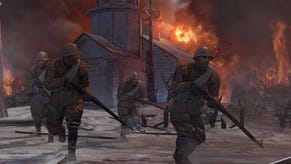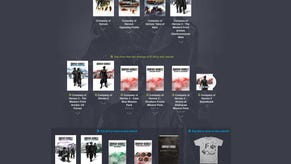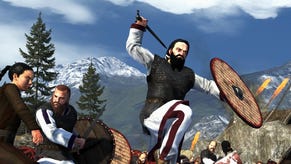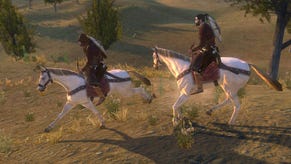Company of Heroes 2 multiplayer: lessons of midwinter
RTS green cadet Stace Harman heads into the frozen wastes of Soviet Russia to receive an education in team-based winter combat, courtesy of Company of Heroes 2.
When I pause to consider how I might fare in humankind’s extinction event, I become acutely aware of my lack of transferable skills. Up to now I’ve prepared as best I can for what I’ve long assumed will be an apocalyptic event that somehow involves zombies.
However, it occurs to me that if it was to come down to old-fashioned human Vs human warfare and if I were called to defend my country, I would have even less chance than I do against the undead.
A couple of hours spent playing commander of both the German and Soviet troops of Company of Heroes 2 has done little to reassure me that I have some untapped gift for tactical warfare. In short, I suck.
Encouragingly, though, I do at least make progress over the course of several rounds of 3 Vs 3 multiplayer. In my case, progress means evolving beyond issuing commands of Blackadder Goes Forth incompetence to learning how not to be a burden to my teammates; in a rare instance or two, I even threaten moments of fleeting glory.
Thanks to two vastly superior players on my 3 Vs 3 team, we still win every round of our Victory Point contests. What’s more, my early lack of coordination and usefulness means I can explore the mechanical elements of Company of Heroes 2 without worrying that my veteran team mates will miss my presence on the frontline.
I familiarise myself with the interface, which is uncluttered and features bold icons that are mostly self-explanatory at a glance. The context sensitive menus for ordering troops and building new ones to replace those you’ve just sent to their death are intuitively nested.
This means there’s never a need drill down several levels to find particular orders and nor is an eidetic memory required to remember where exactly the retreat order lives. This goes some way to helping me improve from awful to merely mediocre as I quickly come to understand the basic orders and the resource system that governs what can be built and when.
The natural structure of my team means that the majority of the troops under my control are infantry. My team mates appear to favour the tanks, scout vehicles and heavy artillery used to push up the snow covered map and although I have access to build such units, I decide to focus on one thing at a time.
This leaves me to guide small units of engineers and foot soldiers to capture and garrison the command posts, ammo dumps and fuel depots that facilitate victory. Following in the persistent tracks of my comrades hulking war machines, my troops brave the cold to push through snow drifts and across frozen lakes.
It’s in this way that, despite my kill/death ratio never climbing higher than the wrong side of 4:1, I’m still able to earn XP and meaningfully contribute to my team by finishing top of the capture table.
“Authenticity is a word we use a lot, because it helps to tie the player to the setting and to the context of what they’re experiencing. But when we talk about authenticity, it isn’t about being bolt-accurate on every tank.”
My poor infantry also have to contend with harsh realities that my vehicular allies do not. The extreme cold of the Soviet battlefield requires troops to build fires if they’re going to stand still to for any length of time, be it to hunker down at a capture point or repair a tank, for example.
Deep pockets of snow are an irritation to cross by foot, as they considerably slow movement but also offer good opportunities to place defensive posts that other foot soldiers have difficulty getting close to.
Meanwhile, the effects of True Sight applies to all units on the battlefield and means that you can only see what your troops can see, which leads to physical barriers such as buildings, trees and abandoned vehicles to become tactical considerations.
Lines of sight are further affected by blizzards that occasionally blow through the snow maps, reducing visibility and driving the temperature down to perilous levels. All of these considerations are intended to enhance the authenticity of conflicts and make squandering troops (leading to the loss of visibility in key areas) especially dangerous.
“Authenticity is a word we use a lot, because it helps to tie the player to the setting and to the context of what they're experiencing,” explains lead designer, Quinn Duffy.
“But when we talk about authenticity, it isn't about being bolt-accurate on every tank. We want to have the intensity and the overall tone add to the immersion. We want the battles to feel tense and on occasion overwhelming, because players get engaged that way as adrenaline levels are driven up.”
Although we’re never really in danger of losing any of our games, there are still plenty of moments that raise the heart rate. This applies to none more so than when a key capture point that I’m defending with upgraded flamethrower troops and a mobile machine gun emplacement is suddenly and violently overrun by enemy troops loaded into half-tracks.
They roar out of gloom and into an undefended flank and I scramble this way and that attempting to keep a bead on the agile off-road vehicles that run rings around my entrenched troops.
It’s at this point that our tactics of rapid expansion and minimal reinforcement are revealed to be fatal folly. The majority of my troops are decimated and the rest beat a hasty retreat, abandoning the capture point to the German forces.
“That's RTS gaming, right? It's all about whether you figure out a strategy to stay in power or get out of a hole” offers Relic executive producer, Jonathan Dowdeswell, when I recount the scene to him later on.
“Sometimes the strategies that emerge are out of desperation, sometimes you can get beaten back to your base and think ‘well, this isn't working’ and so you might go for a Hail Mary, and that might distract your opponents just long enough for you to re-establish a toe-hold.”
Most people will likely have a gentler introduction to the mechanics of Company of Heroes 2, as they’ll invest significant time into the single-player campaign before jumping online to go up against human intelligence.
I feel that I can hold my head high that over the space of a couple of hours I’m able to go from utter novice to a commander with at least some understanding of the dangers cost of waging war in the frozen wastes of Soviet Russia.
However, for the well being of those around me, I hope that it’s zombies and not seasoned RTS players that I have to combat come Judgement Day.
Company of Heroes 2 launches on PC in northern Spring of 2013











